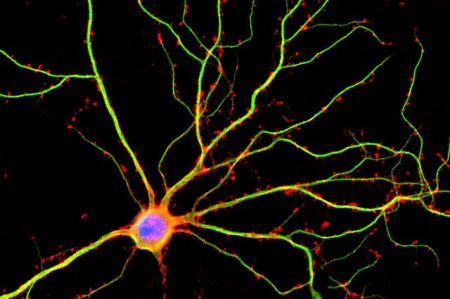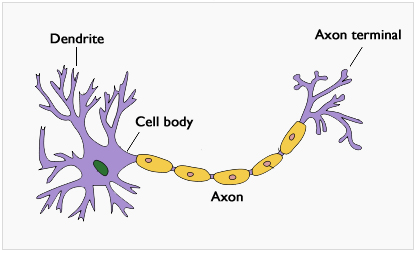
March 13, 2017 – Mayank Mehta, a UCLA neurophysicist, says that our brains don’t work like conventional computers. In a new study, he notes that previous beliefs that neurons acted like digital devices are wrong. The study’s findings, reported in the March 9, 2017, issue of the journal Science, focused on dendrites which are a component of nerve cells in the brain.
Nerve cells, known as neurons (one can be seen in the illustration above) resemble tree-like structures with a cell body surrounded by branchings called dendrites. Each neuron generates an electrical pulse to communicate with nearby nerve cells. These pulses are called spikes. The role of dendrites in this communication was thought to be a passive conduit for the electrical pulses. But what the UCLA researchers have found is that dendrites generate their own electrical activity at a rate 10 times that of the cell body.
Mehta notes that dendrites in a typical nerve cell constitute “more than 90% of neural tissue” and the fact that “they are much more active…fundamentally changes the nature of our understanding of how the brain computes information.”
Why have neuroscientists been so misinformed? Mehta and his team did their study with moving rats as opposed to ones that were stationary. By applying electrodes to the animals they recorded an enormous increase in the brain’s electrical circuitry noting that “decisions are made in the dendrites far more often than in the cell body, and that such computations are not just digital, but also analog.” This alters our assumptions that perception, learning and memory formation are consigned to the cell body alone.
The dendrites generate more than spikes which are similar to the binary off and on switches of the digital computers we use today. The team observed large, varying voltages bigger than the spikes coming from dendrites. Mehta describes the observations as “similar to quantum computers that are analog,” representing “a major departure from what neuroscientists have believed for about 60 years.”
And since dendrites represent a volume 100 times larger than the cell body of neurons, it suggests that the brain has a computational capacity 100 times bigger than we thought.
States Jason Moore, a postdoctoral researcher involved in the study, “it could be that different parts of dendrites will be active at different times, which would suggest a lot more flexibility in how learning can occur within a single neuron.”
The study represents a fundamental change in our understanding of neuron behaviour and may have implications for work on artificial intelligence. Our brains it turns out are digital and quantum computers rolled up in one.










